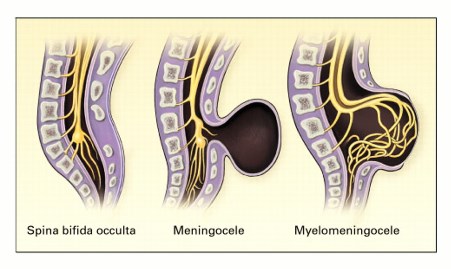There are three main types of Spina Bifida, ranging from minor to severe.
Spina Bifida Occulta (SBO) is often called “hidden Spina Bifida” because about 15 percent of healthy people do not know they have it. Individuals usually find out they have SBO after having an X-ray or MRI of their back. This is considered an incidental finding because the imaging is normally done for other reasons.

Spina Bifida Occulta occurs when the outer part of the vertebrae (the bones of the spine) do not join completely, leaving an opening. In this type of Spina Bifida, the spinal cord and its coverings (the meninges) are not damaged and do not protrude through the opening. There may be a dimple, tuft of hair, birthmark, hyperpigmented patch or fatty bulge at the site of the defect. This type of Spina Bifida is not detected before birth.
Although Spina Bifida Occulta does not usually cause problems, there are some forms of SBO that do, including:
- Lipomyelomeningocele and Lipomeningocele – a tethered spinal cord attached to a benign fatty tumor
- Thickened Filum Terminale – the end of the spinal cord is too thick
- Fatty Filum Terminale – a fatty lump at the inside end of the spinal cord
- Diastematomyelia and Diplomyelia – the spinal cord is split in two, usually by a piece of bone or cartilage
- Dermal Sinus Tract – the spinal canal and the skin of the back are connected by what looks like a band of tissue
Meningocele
Unlike Spina Bifida Occulta, a spinal Meningocele rarely occurs (only 4 percent of neural tube defects). In this type of Spina Bifida, the spinal cord itself is not affected, but its coverings (the meninges) protrude through the opening in the back. Because the spinal cord stays inside the back where it belongs, most individuals with Meningocele are unlikely to suffer long-term health problems. Though cases of tethered cord have been reported. Individuals with this condition may have minor disabilities.
Myelomeningocele
This is the most common and most severe form of Spina Bifida. It occurs when parts of the spinal cord and nerves come through the opening in the back. There is also an absence of muscle and skin that would normally protect the spinal cord. 80 percent of children with Myelomeningocele also have hydrocephalus, an accumulation of fluid in and around the brain. Because of the abnormal development of and damage to the spinal cord, nerve damage is permanent, resulting in varying symptoms, which can include paralysis, bowel and bladder problems and orthopedic deformities. The degree of damage largely depends on the location of the opening in the spine. The higher the opening on the back, the more severe the damage tends to be.
